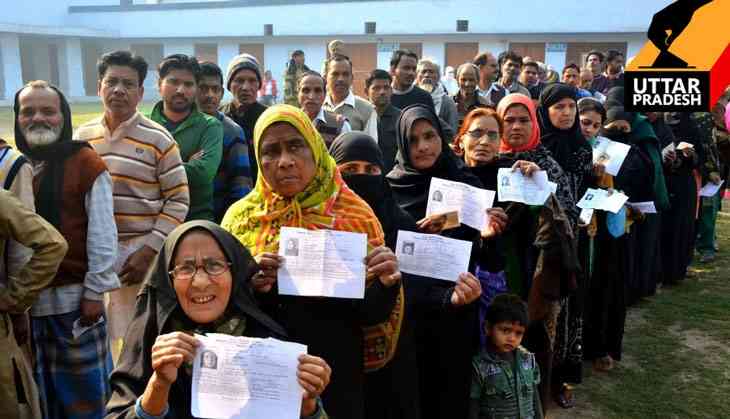Fifth phase of UP election is over. Where do the key players stand?

The fifth phase of the Uttar Pradesh assembly election concluded Monday with just over 57% of the voters casting their ballots. This phase covered the districts of Balrampur, Gonda, Faizabad, Ambedkar Nagar, Bahraich, Basti, Shravasti, Siddharth Nagar, Sant Kabir Nagar, Amethi and Sultanpur.
In Amethi, the contest was particularly interesting, with the allies Samajwadi Party and Congress locked in a “friendly” fight. The SP's candidate is Gayatri Prasad Prajapati and the Congress's is Amita Singh. Challenging them is the BJP's Garima Singh.
With only two more phases to go, covering eastern UP, the contesting parties are busy evaluating their performances. An indication came from no less than Prime Minister Narendra Modi, who has doubled the number of his campaign rallies, suggesting the BJP reckons it hasn't done as well in the five phases so far as it had expected.
Also Read: UP polls: Congress got the alliance with SP, but won't get campaign spotlight
Indeed, the prime minister seemed to admit as much at a rally in Mau on Monday. “After several rounds of voting, I can tell you they are losing,” he claimed, referring to the SP-Congress combine. “People have rejected them. Now, Samajwadi Party, Congress and the Bahujan Samaj Party are working on a new game plan: they are working for a hung assembly.”
His remarks are in sharp contrast to the claims made by BJP president Amit Shah and other senior leaders that the party would get “Prachand Bahumat”. That's, the BJP wouldn't just win a majority, it would sweeping the election.
The BJP's unease, in fact, has been visible for sometime now, not least in its attempts at communal polarisation. At a rally in Fatehpur recently, Modi himself, abandoning the “development pitch” that had largely marked his campaign until then, played the communal card, using the qabristan versus shamshan as the issue.
Political analysts read Modi's statement as the BJP's desperation to polarise the majority Hindu votebank, without which it stands little chance of beating the SP-Congress combine with its formidable Yadav-Muslim votebank and the BSP with its core support base among lower castes.
In the first four phases, no Hindu consolidation appeared to have happened. To the contrary, many sections of the voters that supported the BJP in 2014, like the Jats and sections of the Dalits, stayed away from the party this time.
Still, at that stage, the BJP seemed to be doing better than in the last assembly election in 2012.
It's in the final three phases, however, the situation gets trickier for the BJP. Throwing a spanner in its attempt to consolidate upper-caste and non-Yadav OBC voters, the SP-Congress alliance fielded as many as 67 candidates from these communities. Many of them are sitting legislators with a considerable support base in their constituencies. The BSP, too, has fielded a significant number of Brahmin candidates.
Combined with the absence of a “wave” like the one in 2014 that carried UP for Modi, the run is not going to be easy for the BJP. And the party's election strategists realise that, of course. Hence, the return to the default strategy of raking communal emotions.
Also Read: Mapping the battlefield: 10 hotspots likely to shape the Uttar Pradesh election
To make it harder for the BJP, Muslims are set to play a key role in the last three phases. Muslims made up 22.7% of the voters in the fifth phase held Monday, and they constitute nearly 13% and 10% of the voters, respectively, in the sixth and seventh phases. No less than 21 of the 52 constituencies that went to polls Monday have Muslim populations above 25%.
This is why Mayawati had fielded 18 Muslim candidates on these seats, and why she has been championing the Dalit-Muslim alliance throughout this campaign. The SP-Congress combine, apparently fearing that fielding too many Muslims could lead to a complete Hindu polarisation in favour of the BJP, put up only 10 candidates from the minority community.
But now that the BJP is going back to communal rhetoric, an SP strategist pointed out, it could benefit his party. “Our leader does not have to go all out to woo the Muslims voters. The BJP leaders are doing enough to polarise the Muslim voters in our favour, lending Akhilesh Yadav the image of an inclusive leader focussed on development,” the strategist says, adding that the alliance with the Congress was enough to send a “clear message” to the minorities.
This was indeed evident in the first three phases, at least, when Muslims appeared more inclined to vote for SP-Congress even in constituencies where the BSP had a Muslim candidate. The SP strategist points out that there's no reason for polarisation of votes in the remaining phases and that may be the reason for BJP's desperation. “In 2014, they had a figure in Modi around whom the voters gravitated. In this election, they don't have any such figure. Modi is not going to be enough,” another strategist from the SP camp claims.
The SP, though, is worried by the BJP's messaging blitzkrieg of “we are forming the government”. As the strategist complains, “Many BJP leaders manage to make it to the front pages of newspapers, while the SP only has Akhilesh Yadav who gets space in the media.”
The BJP, on its part, is banking on the division of the minority votes in some of the constituencies where Muslim votes could swing the result. Even if that happens, the BJP must cover a lot of ground in the last three phases if it has to form the government.
Also Read: Two-thirds of UP has voted. Who is ahead at this stage?

